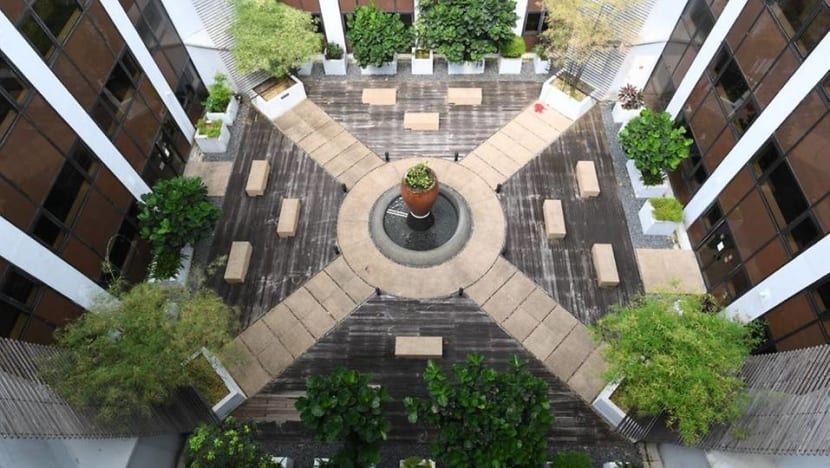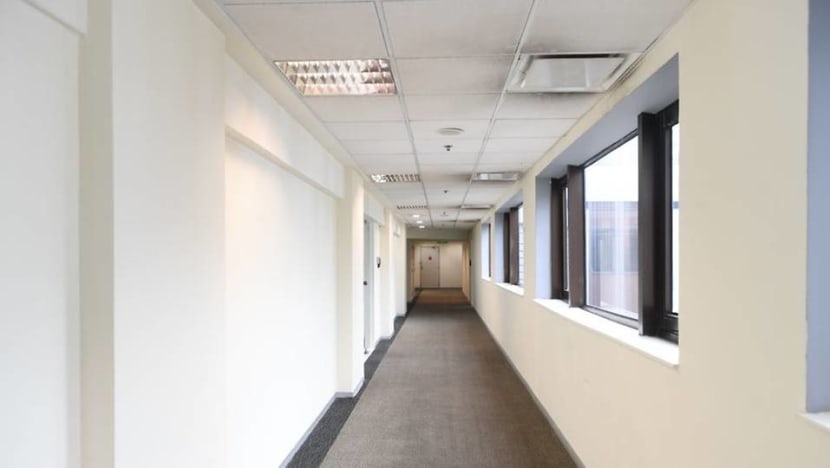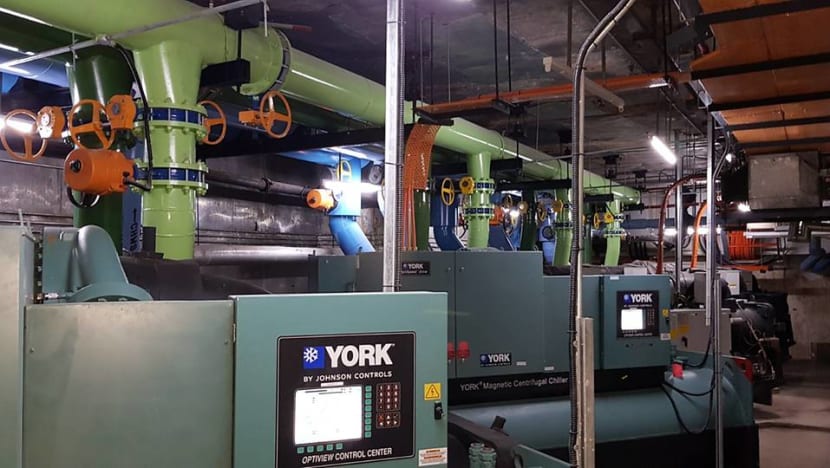High costs and logistical issues: The challenges of greening Singapore's older buildings

The exterior of The Adelphi, a retail and office building at the intersection of Coleman Street and North Bridge Road. (Photo: The Adelphi)
SINGAPORE: A concrete grey exterior bearing signs of age gives away the fact that The Adelphi, at the heart of City Hall, is not the newest building on the block.
But housed within this retail and office development, built in 1985, are modern energy systems that have bagged it numerous top accolades.
The building overhauled its chiller plant and fittings a few years ago, helping it cut back on 137 tonnes of carbon dioxide emissions every year – the annual output of 714 four-room public housing flats.
This has also helped it save about half a million dollars in energy costs each year, said Sanjay Samnani, the treasurer of the building’s management corporation (MCST).
READ: New and existing buildings required to be more energy efficient under revised BCA standards
Getting to this stage was no small feat. As an existing building, it could only be retrofitted with the permission of all 347 sole proprietors who own units within it.
“You have to get everyone involved and … the challenges are very clear: it’s lots of money,” said Mr Sanjay, adding that the changes were to cost S$4 million.
Mr Jehu Chan, the MCST’s chairman, added that stakeholders had several considerations: “How much savings do we get out of it? Do we get better air quality? Does it provide enhancement to value of our assets?”
They eventually got the green light from owners after proposing to work with an energy performance contractor, Comfort Management, who would foot the upfront capital and share the savings with them.

Even after that, logistics were disruptive. “It was not easy because we had to get … participation from building occupants, typically to enter their premises (for renovation),” said Mr Sanjay.
These elements that management had to deal with are not uncommon among ageing buildings looking to lower their carbon footprints.
In fact, it’s often much trickier to green older developments than new ones, experts told CNA.
READ: Sustainability targets for built environment sector under newest Green Building Masterplan
Despite this, progress will be needed on this front if Singapore is to achieve its goal of greening 80 per cent of buildings by gross floor area (GFA) by 2030 - a target it committed to amid a nationwide push for sustainability.
So far, some 43 per cent, or 126 million square metres, has been covered.
But the remaining 57 per cent of buildings yet to be greened are about 26 years old on average, the Building and Construction Authority (BCA) told CNA.
About one-third of these are non-residential buildings, while the rest are residential.
CHALLENGES FOR OLDER BUILDINGS
Mr Wong Heang Fine, the Group CEO of Surbana Jurong, said it is more complex to reduce the carbon footprint of older buildings because one has to work within many existing parameters.
“It depends on things like how the building is oriented – if it’s (west-facing), it absorbs a lot of heat during the day and then your cooling load for the building goes up, and of course, the carbon emissions will also go up.”
The materials used also matter – brick is more insulating, while glass facades allow more heat in, said Mr Wong. Not much can be done to reduce the embodied carbon in the existing structure either, he added.

Another factor is whether the building is owned by a single entity or several parties. Not all developments will be in the same position as The Adelphi, where owners gave their blessing for green initiatives without “much resistance”, as Mr Chan put it.
“Getting all the owners to agree is extremely difficult … A lot of the time, the owners are not staying in (a) residential building (and they) rent it out. So to them, they don't feel the need to invest in newer systems,” said Mr Wong.
Mr Qiu Xuan, the Deputy General Manager for Comfort Management, echoed this: “Everyone has their own opinion because they own the unit for different purposes, so it’s hard to get everyone to draw (a consensus).”
On top of that, the large capital investment needed often leads building owners to hesitate, especially amid the COVID-19 pandemic said Mr Xuan.
This sum can be partially offset by government grants, raised by the owners, or financed by contractors, as in The Adelphi’s case.
LISTEN: Greening Singapore’s buildings: What makes a building green anyway?
BCA has offered numerous cash-based incentive schemes for owners, but a check on the authority's site showed that some have expired or been fully-committed.
One of those which remains open is the Building Retrofit Energy Efficiency Financing scheme, which offers a loan of up to S$4 million or 90 per cent of the total cost to implement energy efficient equipment.
BCA told CNA that, so far, loans worth more than S$30 million have been offered to close to 20 building owners. It added that this scheme will be reviewed before it expires in 2023.
READ: BCA's green building innovation grant gets S$20 million top-up
While initial outlays can be high, the savings often make sense, the experts said. There are other benefits too: The Adelphi won the ASEAN Energy Award last year, and received a Green Mark Platinum Certificate in 2017 – the highest rating for a building’s environmental impact and performance.
These all enhance the image of the building and its owners, Mr Chan said. He described another benefit: “We managed to remove (an old chiller) and this enabled us to free up rentable space!”

GOING BEYOND IS “EXPONENTIALLY” HARDER
Singapore has other ambitious goals, such as aiming for 80 per cent of new buildings by GFA to be Super Low Energy (SLE) ones by 2030.
This category goes above the Green Mark Platinum standard, the highest in the framework, and buildings must achieve at least a 60 per cent improvement in energy efficiency compared to 2005 levels.
They represent “the next wave” of the green building movement, said National Development Minister Desmond Lee in March.
But since the launch of the Green Mark SLE programme in 2018, only about 1 per cent of new developments by GFA have been certified to meet the standard yearly, BCA told CNA.
It added that the Government will “take the lead” in bringing SLE buildings into the mainstream, and that it is exploring more measures to drive the private sector to adopt these practices.
READ: New and existing buildings required to be more energy efficient under revised BCA standards
Surbana Jurong’s Mr Wong said: “To achieve Green Mark Platinum is already a very big step. There is cost involved in it. To go one more mark above, it’s extremely difficult – it’s not just proportionate, it’s quite exponential.”
To improve this statistic, Mr Xuan highlighted the importance of financial support.
“If let’s say the Government gives incentives (like it has for the Green Mark scheme) over the past 10 years or so, it does shorten the payback period. It helps the building to move further and helps them make a decision faster,” he said.
Specifically, Mr Wong suggested dangling the carrot of bonus GFA for buildings that hit SLE standards. This was offered under the Green Mark scheme.
READ: Commentary: Reaching net-zero emissions will be ‘very challenging’. But watch Singapore try anyway
At the same time, more R&D efforts should be undertaken to see “how much better (buildings can be) beyond the baseline”, said Mr Xuan.
As building owners prepare for a greener future, Mr Wong also suggested more cross-agency coordination on policies. Citing a recent nationwide push towards electric vehicles, he said this would mean charging points would need to be built in developments.
But this would likely raise the building’s electricity consumption, going against the broader move to cut energy use, he said.
Ultimately, these efforts must be supplemented by more awareness among the public and building tenants about the underlying need for all these moves - to slow climate change and its detrimental impacts, said Mr Xuan.
Editor's note: Information in this article about the proportion of residential and non-residential buildings which have yet to be greened has been updated after BCA amended the information provided to CNA.














